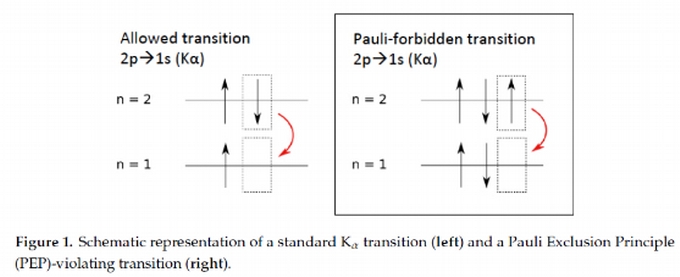The Messiah–Greenberg (MG) superselection rule [1] prevents transitions among states with different symmetry. Accordingly, a PEP-violating signal is to be searched in open quantum systems, i.e., by looking for transitions among violating states of a prepared system after the introduction of particles from outside of the considered system. Transitions among anomalous states would occur at the standard rate if the involved particles couple universally to the interaction field. The VIP-2 Open Systems experiment tests PEP violation (see e.g., Refs. [2-13]) constrained by the MG superselection rule.
The experimental method was suggested by Greenberg and Mohapatra [11] and a first experiment was performed by Ramberg and Snow [14]. The idea is to circulate a Direct Current (DC) in a copper strip conductor and look for anomalous Kalpha transitions. An anomalous transition may occur if a new electron, injected into the copper strip, forms a wrong symmetry state with the electrons in the inner shell of a copper atom. The electron would be captured by the atom and emit anomalous X-rays as it cascades down to the fundamental level of the non-Paulian atom. The signature of a PEP violation would then be the detection of a PEP-violating Kalpha transition, which is a 2p -> 1s transition with the 1s level already occupied by two electrons. The anomalous Kalpha transition would be shifted by about 300 eV as a consequence of the extra shielding provided by the two electrons residing in the 1s state of the atom (see Refs. [15,16] for the details of the calculation). A reference background spectrum is collected with no circulating current.

Improving our best knowledge for an electron to violate PEP in open systems
The VIP experiment (VIolation of Pauli exclusion principle) is a greatly improved version of the concept pioneered by Ramberg and Snow. The measurement was performed at the LNGS underground low radioactivity laboratory, where the shielding of the Gran Sasso mountain provides a reduction of the cosmic ray origin background of six orders of magnitude. The VIP experiment further made use of Charge Coupled Devices (CCDs) as X-ray detectors, with a typical energy resolution of 320 eV at 8 keV which allowed a precise definition of the energy window within which the anomalous X-rays are expected to be observed.
The probability of a small violation is represented conventionally in the form of a small violation probability β^2/2 parameter, first introduced by Ignatiev and Kuzmin [9]. The VIP experiment set the best limit for the probability of the PEP violation for electrons, respecting the MG superselection rule: β^2/2 < 4.7 × 10^-29 [17-19] improving the Ranberg and snow result of a factor 400.
With the VIP-2 experiment we intend to further improve the sensitivity by two orders of magnitude at least in the search for PEP violating events. To this end the experimental apparatus was substantially upgraded, among the major improvments:
The Charge Coupled Devices (CCDs) X-ray detectors were replaced with Silicon Drift Detectors (SDDs), characterised by a better energy resolution Full Width at Half Maximum (FWHM) of about 190 eV FWHM at 8 keV. Moreover the SDDs are fast, triggerable detectors, which allowed the introduction of a veto system.
The target was reshaped in order to increase the geometric acceptance. The target is cooled down by a closed chiller circuit, the lower temperature rise caused by the heat dissipation in copper allowed to increase the circulating DC current from 40 A (in VIP) to 100 A. The higher current traduces in a bigger number of injected test electrons.
From the analysis of a first tranche of data collected in 2018 the upper limit on the PEP violation probability was already significatively improved β^2/2 < ????? IL LIMITE DA QUESTA REFERNZA VA TRADOTTO DACLOSE ENCOUNTERS A SCATTERS [20]. The experiment is still acquiring data, and the result of the analysis of the whole collected data set will be available soon.
We are presently working on a new setup, for the test of PEP in open systems of electrons, based on innovative 1 mm thick SDD detectors, which we are developing in collaboration with FBK Trento. The improved detection efficiency for photons in the range (20-30) keV, will allow to perform a broader scan of the PEP violation probability, as a function of the atomic number Z, by employing ultrapure silver and palladium targets.
References
- [1]. Messiah, A.M.L.; Greenberg, O.W. Symmetrization Postulate and Its Experimental Foundation. Phys. Rev. 1964, 136, B248–B267.
- [2]. Gentile j, G. osservazioni sopra le statistiche intermedie. Il Nuovo Cimento 1940, 17, 493–497.
- [3]. Greenberg, O. Interactions of particles having small violations of statistics. Phys. A Stat. Mech. Appl. 1992, 180, 419–427.
- [4]. Green, H.S. A generalized method of field quantization. Phys. Rev. 1953, 90, 270.
- [5]. Dell’Antonio, G.; Greenberg, O.; Sudarshan, E. Group Theoretical Concepts and Methods in Elementary Particle Physics; Lectures at the Istanbul Summer School of Theoretical Physics; Gürsey, F., Ed.; Gordon and Breach: New York, NY, USA, 1964; p. 403.
- [6]. Fermi, E. Le Ultime Particelle Costitutive Della Materia. Scientia 1934, 28, 21.
- [7]. Milotti, E. Enrico Fermi’s view of identical particles. arXiv 2007, arXiv:physics.hist-ph/0705.1363.
- [8]. Govorkov, A. The existence of antiparticles seems to forbid violations of statistics. Phys. A Stat. Mech. Appl. 1994, 203, 655–670.
- [9]. Ignatiev, A.Y.; Kuzmin, V. Is small violation of the Pauli principle possible? In Quarks ’86: Proceedings of the Seminar, Tbilisi, USSR, 15–17 April 1986; Tavkhelidze, A.N., Matveev, V.A., Pivovarov, A.A., Tkachev, I.I., Eds.; VNU Science Press BV: Utrecht, The Netherlands, 1987; pp. 263–268.
- [10]. Ignatiev, A.Y. X rays test the Pauli exclusion principle. Radiat. Phys. Chem. 2006, 75, 2090–2096.
- [11]. Greenberg, O.W.; Mohapatra, R.N. Local Quantum Field Theory of Possible Violation of the Pauli Principle. Phys. Rev. Lett. 1987, 59, 2507–2510.
- [12]. Okun, L.B. Possible violation of the Pauli principle in atoms. JETP Lett. 1987, 46, 420–422.
- [13]. Amado, R.D.; Primakoff, H. Comments on testing the Pauli principle. Phys. Rev. C 1980, 22, 1338–1340.
- [14]. Ramberg, E.; Snow, G.A. Experimental limit on a small violation of the Pauli principle. Phys. Lett. B 1990, 238, 438–441.
- [15]. Shi, H.; Milotti, E.; Bartalucci, S.; Bazzi, M.; Bertolucci, S.; Bragadireanu, A.; Cargnelli, M.; Clozza, A.; De Paolis, L.; Di Matteo, S.; et al. Experimental search for the violation of Pauli exclusion principle. Eur. Phys. J.C 2018, 78, 319.
- [16]. Curceanu, C.; De Paolis, L.; Di Matteo, S.; Di Matteo, H.; Sperandio, S. Evaluation of the X-Ray Transition Energies for the Pauli-Principle-Violating Atomic Transitions in Several Elements by Using the Dirac-Fock Method; Technical Report; LNF Preprint, INFN-13-21/LNF, 21-11-2013; SIDS-Pubblicazioni Laboratori Nazionali di Frascati: Frascati, Rome, Italy, 2013.
- [17]. C. Curceanu et al., J. Phys. Conf. Ser. 306, 012036 (2011)
- [18]. S. Bartalucci et al., Found. Phys. 40, 765 (2009)
- [19]. L. Sperandio, PhD thesis. New experimental limit on the Pauli exclusion principle violation by electrons from the VIP experiment. Tor Vergata University, Rome (2008)
- [20]. K. Piscicchia et al., Entropy 2020, 22(11), 1195
